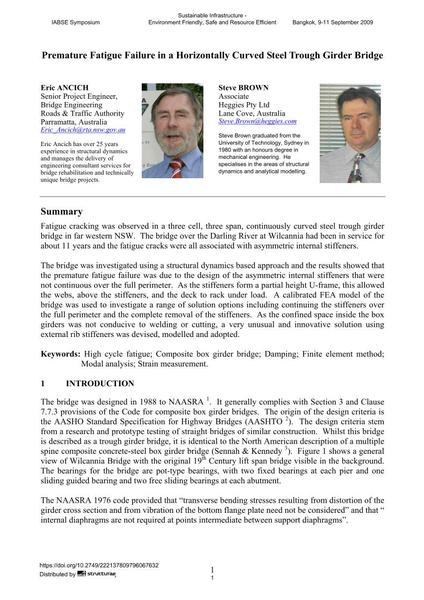Premature Fatigue Failure in a Horizontally Curved Steel Trough Girder Bridge

|
|
|||||||||||
Bibliografische Angaben
| Autor(en): |
Eric Ancich
Steve Brown |
||||
|---|---|---|---|---|---|
| Medium: | Tagungsbeitrag | ||||
| Sprache(n): | Englisch | ||||
| Tagung: | IABSE Symposium: Sustainable Infrastructure - Environment Friendly, Safe and Resource Efficient, Bangkok, Thailand, 9-11 September 2009 | ||||
| Veröffentlicht in: | IABSE Symposium Bangkok 2009 | ||||
|
|||||
| Seite(n): | 41-64 | ||||
| Anzahl der Seiten (im PDF): | 24 | ||||
| Jahr: | 2009 | ||||
| DOI: | 10.2749/222137809796067632 | ||||
| Abstrakt: |
Fatigue cracking was observed in a three cell, three span, continuously curved steel trough girder bridge in far western NSW. The bridge over the Darling River at Wilcannia had been in service for about 11 years and the fatigue cracks were all associated with asymmetric internal stiffeners. The bridge was investigated using a structural dynamics based approach and the results showed that the premature fatigue failure was due to the design of the asymmetric internal stiffeners that were not continuous over the full perimeter. As the stiffeners form a partial height U-frame, this allowed the webs, above the stiffeners, and the deck to rack under load. A calibrated FEA model of the bridge was used to investigate a range of solution options including continuing the stiffeners over the full perimeter and the complete removal of the stiffeners. As the confined space inside the box girders was not conducive to welding or cutting, a very unusual and innovative solution using external rib stiffeners was devised, modelled and adopted. |
||||
| Stichwörter: |
Finite-Elemente-Methode (FEM) FEM Modalanalyse Dämpfung Verbundhohlkastenbrücke
|
||||
